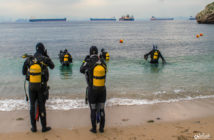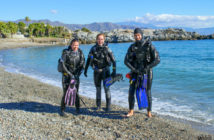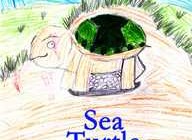The scuba diving around Gibraltar is world famous and has been on my radar for quite some time. After a great dive last month near Nerja, further east along the Costa del Sol, I promised I would be diving there soon. It didn’t take long before Simply Diving, Torremolinos contacted me to say they were running a Gibraltar trip and there was no way I was going to miss it! I didn’t ask which dive sites were on the schedule for the day; I didn’t care. The actual sites didn’t matter to me; I just wanted to be back under water and seeing the beautiful marine life the area has to offer. Some people care about specifics, but I like to appreciate each dive for what it is.
Gibraltar is at the Southern tip of Europe and is at the gateway to the Mediterranean Sea, where the Atlantic Ocean flows into the gap between Europe and Africa. The water in this area is described as temperate, and sits between the Tropic of Cancer and the Arctic Circle. Temperate means that this area experiences hot summers and cold winters, with ocean currents flowing in both directions between the two. These crossing currents create a nutrient rich environment and a thriving home for plankton, which in turn provides a great restaurant for many fish species.
On the day of the dive, we met at the dive centre at 8am, meaning an early start. Early for me anyway, as I was travelling down from the Spanish Lake District, just over an hour away. The crew remembered all my kit sizes and weight requirements from the previous month (this was a nice personal touch) and loaded everything in to the van ready for the day.
From the dive centre, it’s roughly a two hour drive to The Rock. As we were crossing an International border we all had to take and show our passports. Sadly there were no stamps to be added to mine because Gibraltar is still a British Overseas Territory.
At the dive site the water looked like a mill pond and there was virtually no wind. Perfect diving conditions for a shore entry. We were diving in Camp Bay Conservation Site, Europe’s first artificial reef. This site sits at the South Eastern end of the outcrop, with views across the bay back to Spain and across the Straits to Africa. There have been 11 wrecks dropped into this bay over the past 30 years to create a beautiful divers playground full of marine life.
Steve, my fiancé, had a bad cold and couldn’t equalise so was taking surface shots and acting as surface support on the beach. He is usually the underwater photographer, but for this dive I had borrowed a GoPro. I was super excited to be diving these wrecks, but also excited to get some photos of the promised nudibranchs.
We were scheduled to do two dives, Camp Bay Left and Camp Bay Right. This area is known as Tres Bargos, because, as the name suggests there are 3 boats to explore, all very close to each other.
The Simply Diving guys set up everybody’s kit for them, doing safety checks as they did so. The rest of us were enjoying the view and marvelling at how close the mountains of Morocco looked.
For the first dive, I was buddied with Instructor Dan, whilst the others went with Dive Master Paco and Instructor Carl. This was going to be an awesome chilled out dive, and despite the low temperature I couldn’t wait to get into the water.
We entered from the shore and only swam a short distance before we descended. I was again struck by how fresh the water tasted. Swimming a short distance we came across a murky structure up ahead. Visibility was around 10-15 metres and perfect for floating close to a wreck and seeing what delights it had to offer. This was our first wreck and it was completely covered in life, with lots of fish swimming around. It wasn’t long until I spotted my first nudi of the day. After spotting the first one, they seemed to be everywhere. I spotted different flabellinas and other aeolids, a few different species of Hypselodoris and some Felimare. Throughout the dive I spotted a lot of fish too – bass, bream and mullet to name a few. There were also some interesting sea pens.
There were two wrecks sitting side by side, which created a beautiful false canyon between the two. There were some interesting structural aspects and lines to enjoy, which created some imposing impressions and panoramic views through and across the boats. It was really enjoyable floating between the wrecks and also swimming over the top to get a real feel for the shape of each boat.
The water temperature was 14 degrees and I felt a little chilly towards the end of the dive when we exited the water after almost 50 minutes. (Thanks Dan, but don’t tell the boss! The dive was scheduled to be a maximum of 45 minutes).
The dive crew changed our tanks for us during the surface interval and we huddled together and chatted about the beautiful wrecks and the colourful life that we’d just seen. Some of the others were quite cold and wanted to cut the next dive down to 30 minutes. I was pretty chilly at this point and this sounded like a good idea, but I knew that once I was back under the water I wouldn’t want to get out again!
For the second and final dive of the day, we went in as a big group and this time went to the right of the bay. Funnily enough, now I was back under water, I didn’t feel as cold and was absorbed in the beauty of the dive and nudi spotting. Some of the group did exit the water after half an hour however Dan, Carl, another customer and I carried on for another 15 minutes, exploring the wreck and seeing what life lived in and around it.
I had expected there to be big currents around Gibraltar as the higher Atlantic Ocean flows into the lower sitting Mediterranean, but on the day that we dove, there was only a gentle current which we swam into on the way out and floated with on the way back to shore. Alongside the vibrant colours and the stunning marine life, this made for two very pleasant and relaxed dives, which left me craving more of what this coast line has to offer.
On a final note, I mentioned that I took a GoPro with me. This wasn’t my camera and I made a rookie mistake by not checking all the settings before I entered the water. There was a delay set on taking photographs and although I held the camera steady whilst taking a shot, by the time the delay was ready to shoot, I was moving again. Lesson to all budding photographers, get to know your equipment and check all settings before using anything for the first time. Or, take a Steve with you and just enjoy the dive!












